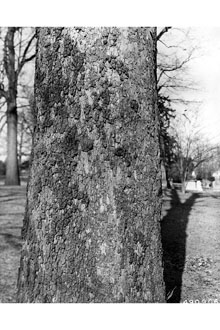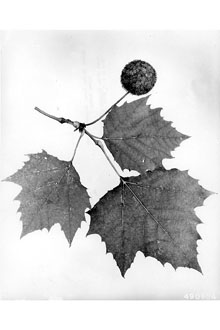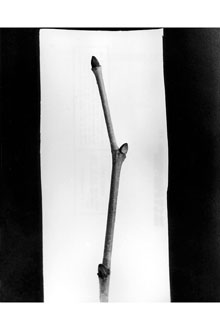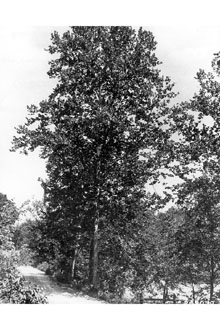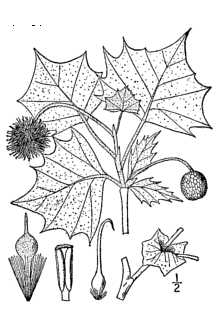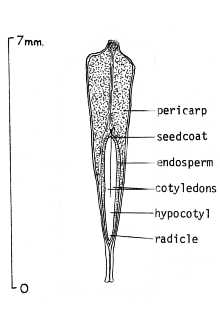American Sycamore
Scientific Name: Platanus occidentalis L.
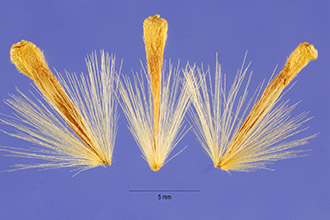
| General Information | |
|---|---|
| Usda Symbol | PLOC |
| Group | Dicot |
| Life Cycle | Perennial |
| Growth Habits | Tree |
| Native Locations | PLOC |
Plant Guide
Uses
Industry: American sycamore is grown in short-rotation plantations primarily for pulp and it also is used for rough lumber, The heavy, close-grained wood is difficult to split and work because of interlocking fibers, It has been used for butcher's blocks, furniture, veneer and interior trim, boxes and crates, flooring, and particle and fiberboard, Conservation: American sycamore is a good planting where a large, fast-growing tree is desired, Negative features are the relatively weak limbs (susceptible to wind and ice damage) and the large leaves that decay slowly after falling, The huge size quickly attained by these trees is often underestimated, The London planetree, Platanus hybrida Brot, (= Platanus acerifolia (Ait,) Willd,), is widely planted as a street tree, probably due to its disease resistance and tolerance of air pollution (American sycamore is susceptible to ozone damage), The London plane is a hybrid between American sycamore and oriental plane (P, orientalis) and perhaps includes a number of backcrosses, American sycamore is recommended for planting on all types of strip-mined land, and it is useful in rehabilitation of various sites with saturated soils, It is often a natural early colonizer of disturbed sites such as old fields, spoil banks, streambanks degraded by channelization, and waterway disposal sites, Oklahoma Biological Survey Ethnobotanic: Native Americans used sycamore for a variety of medicinal purposes, including cold and cough remedies, as well as dietary, dermatological, gynecological, respiratory, and gastrointestinal aids, Use soil moisture sensors to measure the soil moisture of American Sycamore.,
Status
Please consult the PLANTS Web site and your State Department of Natural Resources for this plant’s current status (e.g. threatened or endangered species, state noxious status, and wetland indicator values).
Description
General: Planetree family (Platanaceae). Monoecious, native, deciduous trees with an open crown, among the largest of Eastern deciduous forests, reaching heights of 18-37 meters, and the greatest diameter of any temperate hardwood tree -- the largest known range 3-4 meters d.b.h.; twigs zig-zag, with only lateral buds, these completely covered by a single scale within the petiole base and not visible until after the petiole detachment; bark of upper trunk exfoliating in patches, leaving areas of inner bark exposed, a patchwork of browns, yellows, and greens against a background of white, the darker bark with age falling away in thin brittle sheets, exposing younger and lighter-colored bark. Leaves are deciduous, alternate, 10-35 cm long, palmate-veined and roughly star-shaped, with 3-5 sharp lobes, the blades often as broad or broader than they are long, truncate to cordate at the base, on petioles to 12 cm long; a leaf-like stipule at the petiole base is persistent during early growth. Staminate and pistillate flowers in separate, tightly compacted, ball-shaped clusters. Fruit is single-seeded and indehiscent (an achene), 8-9 mm long, with a ring of bristles at the base, numerous achenes in a pendulous, ball-shaped fruiting head 2-5 cm in diameter, the individual achenes drifting in the wind if the head breaks up on the tree. Common name apparently borrowed from the European sycamore maple (Acer pseudoplatanus L.), which has similar leaves. That name in turn comes from the Middle Eastern sycomore fig, Ficus sycomorus L., its specific epithet from the Greek “sykomoros,” mulberry. Variation within the species: geographic variation in sycamore is extensive, but variants are not currently formally recognized. Platanus occidentalis var. glabrata and P. occidentalis var. attenuata are treated as synonyms of the typical expression. The similar London planetree (below) distinguished by the lobes of its larger leaves being somewhat longer and narrower (often longer than wide), the fruiting heads 1-2 on each stalk, and the bark often somewhat greener.
Distribution
American sycamore is widespread in the eastern United States, from Texas to Nebraska, Iowa, and Wisconsin and into southern Ontario, Canada; apparently extirpated in Maine. It also occurs in the mountains of northeastern Mexico. For current distribution, please consult the Plant Profile page for this species on the PLANTS Web site.
Adaptation
It often is a pioneer on upland sites in the central part of its range, but it is primarily a species of bottomland and alluvial soils, also occurring on creek banks, mesic coves and lower slopes, on a wide range of soil types. It is a major pioneer species in the floodplains of large rivers and occurs on a variety of wet sites, including shallow swamps, sloughs, and wet river bottoms where soil is saturated 2-4 months during the growing season. Water dispersal often results in seed deposition on muddy flats highly conducive to germination because seed dispersal occurs when water is receding after spring floods. American sycamore is most commonly found in mixture with sweetgum, boxelder, silver and red maple, cottonwood, and willows. It is found at 0-300 (-750) meter elevation. American sycamore can tolerate weeks of flooding, even complete submersion of seedlings, provided that the water is aerated. A significant portion of young sycamores can survive almost 2 months of continuously waterlogged soils during dormancy, but sycamore of various stages will die if the entire tree is inundated for more than two weeks during the growing season. Saplings top-killed by flooding may resprout from the root crown. Flowers appear with the leaves in April-May or as early as late March in the South. Fruits ripen September-October (-November), usually breaking up and falling from the tree through the winter and into spring.
Establishment
Open-grown American sycamores usually begin flowering in 6-7 years. Natural stands of sycamore usually produce appreciable numbers of seed at approximately 25 years; optimum seed production occurs from 50-200 years of age. Good seed crops are produced every 1-2 years. Sycamore seeds do not require any pretreatment for good germination. They do not germinate well in heavy litter or in deep shade or in temperatures outside of 59-86 o Fahrenheit (15-30 o C.). Sycamore seedlings require direct sunlight for good growth and establishment, except perhaps on clay soil. One-year-old seedlings may reach 10 feet, and sprouts may reach 25 feet. The potentially great size of mature trees is correlated with exceptionally rapid growth, and maximum age probably does not exceed 250 years, although Smith (1952) notes that 500-600 may be the upper range.
Management
American sycamore can be regenerated from natural seed sources, by planting, or by stump and root sprouting. On "silvicultural biomass farms" aimed at maximum fiber production, fertilization is usually necessary, especially with rotations shorter than 5 years. Sycamores in managed plantations interplanted with legumes or other nitrogen-fixing species were larger than control plants 6 years after establishment of the nitrogen fixers. Sycamore has good coppice regeneration potential, although it has been reported that trees died after two successive harvests. A high percentage of stumps sprout, regardless of stump size or time of harvest, although larger and heavier sprouts are produced from dormant season cuts (vs. growing season). Significant diseases and insect problems occur in managed plantations and landscaping trees of American sycamore but are largely absent from natural stands. Important problems include anthracnose and eastern mistletoe (Phoradendron spp.). Prescribed fire is not recommended for bottomland forests in which sycamore occurs. Bottomland fires usually move rapidly along the surface, consuming shrubs and herbs and usually killing saplings and seedlings of all species. Larger trees suffer bark wounds that create points of entry for rots, stains, and insects. Under extreme conditions, large trees may be killed outright. Fire also reduces soil organic layers, leading to site degradation. Cultivars, Improved and Selected Materials (and area of origin) These plant materials are readily available from commercial sources. Contact your local Natural Resources Conservation Service (formerly Soil Conservation Service) office for more information. Look in the phone book under ”United States Government.” The Natural Resources
Conservation
Service will be listed under the subheading “Department of Agriculture.”
References
Elias, T.S. 1980. The complete trees of North America: Field guide and natural history. Van Nostrand Reinhold, New York, New York. Kaul, R.B. 1997. Platanaceae. Pp. 358-361, IN: Flora of North America, North of Mexico. Vol. 3. Oxford Univ. Press, New York, New York. <http://hua.huh.harvard.edu/cgi-bin/Flora/flora.pl?FLORA_ID=12395> Oklahoma Biological Survey 2000. Platanus occidentalis. IN: Catalogue of woody plants of Oklahoma. Norman, Oklahoma. 22sep2000. <http://www.biosurvey.ou.edu/> Santamour, F.S. Jr. 1972. Interspecific hybridization in Platanus. Forest Sci. 18: 236-239. Smith, N.F. 1952. Trees of Michigan and the Upper Great Lakes. Thunder Bay Press, Lansing, Michigan. Sullivan, J. 1994. Platanus occidentalis. IN: W.C. Fischer (compiler). The Fire Effects Information System [Database]. USDA, Forest Service, Intermountain Research Station, Intermountain Fire Sciences Laboratory, Missoula, Montana. <http://www.fs.fed.us/database/feis/> Wells, O.O. & R.C. Schmidtling 1990. Platanus occidentalis. Pp. 511-517, IN R.M. Burns and B.H. Honkala. Silvics of North America. Volume 2. Hardwoods. USDA Forest Service Agric. Handbook 654, Washington, D.C. <http://willow.ncfes.umn.edu/silvics_manual/Table_of_contents.htm>
Plant Traits
Growth Requirements
| Temperature, Minimum (°F) | -34 |
|---|---|
| Adapted to Coarse Textured Soils | Yes |
| Adapted to Fine Textured Soils | No |
| Adapted to Medium Textured Soils | Yes |
| Anaerobic Tolerance | Medium |
| CaCO3 Tolerance | None |
| Cold Stratification Required | No |
| Drought Tolerance | Low |
| Fertility Requirement | Medium |
| Fire Tolerance | Medium |
| Frost Free Days, Minimum | 100 |
| Hedge Tolerance | None |
| Moisture Use | High |
| pH, Maximum | 6.5 |
| pH, Minimum | 4.9 |
| Planting Density per Acre, Maxim | 800 |
| Planting Density per Acre, Minim | 300 |
| Precipitation, Maximum | 80 |
| Precipitation, Minimum | 30 |
| Root Depth, Minimum (inches) | 30 |
| Salinity Tolerance | None |
| Shade Tolerance | Intermediate |
Morphology/Physiology
| Bloat | None |
|---|---|
| Toxicity | None |
| Resprout Ability | Yes |
| Shape and Orientation | Erect |
| Active Growth Period | Spring and Summer |
| C:N Ratio | High |
| Coppice Potential | Yes |
| Fall Conspicuous | Yes |
| Fire Resistant | No |
| Flower Color | Red |
| Flower Conspicuous | No |
| Foliage Color | Green |
| Foliage Porosity Summer | Dense |
| Foliage Porosity Winter | Porous |
| Foliage Texture | Coarse |
| Fruit/Seed Conspicuous | Yes |
| Nitrogen Fixation | None |
| Low Growing Grass | No |
| Lifespan | Long |
| Leaf Retention | No |
| Known Allelopath | No |
| Height, Mature (feet) | 100.0 |
| Height at 20 Years, Maximum (fee | 65 |
| Growth Rate | Rapid |
| Growth Form | Single Stem |
| Fruit/Seed Color | Brown |
Reproduction
| Vegetative Spread Rate | Slow |
|---|---|
| Small Grain | No |
| Seedling Vigor | Medium |
| Seed Spread Rate | Moderate |
| Fruit/Seed Period End | Fall |
| Seed per Pound | 192000 |
| Propagated by Tubers | No |
| Propagated by Sprigs | No |
| Propagated by Sod | No |
| Propagated by Seed | Yes |
| Propagated by Corm | No |
| Propagated by Container | Yes |
| Propagated by Bulb | No |
| Propagated by Bare Root | Yes |
| Fruit/Seed Persistence | Yes |
| Fruit/Seed Period Begin | Summer |
| Fruit/Seed Abundance | Medium |
| Commercial Availability | Routinely Available |
| Bloom Period | Spring |
| Propagated by Cuttings | Yes |
Suitability/Use
| Veneer Product | No |
|---|---|
| Pulpwood Product | No |
| Post Product | No |
| Palatable Human | No |
| Palatable Browse Animal | Low |
| Nursery Stock Product | Yes |
| Naval Store Product | No |
| Lumber Product | Yes |
| Fuelwood Product | Low |
| Fodder Product | No |
| Christmas Tree Product | No |
| Berry/Nut/Seed Product | No |

